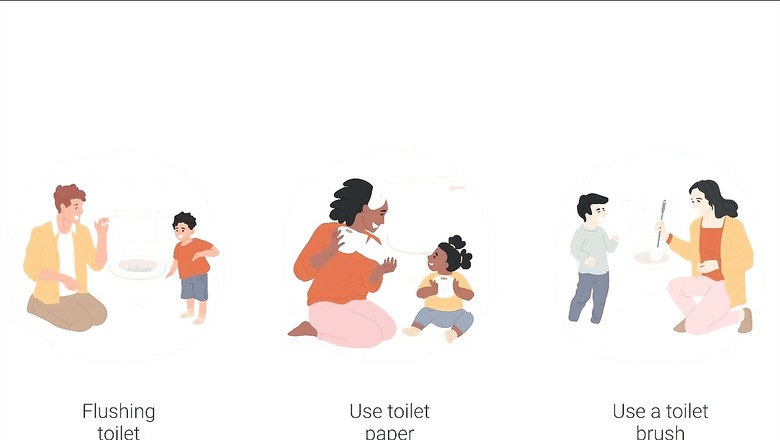
views
While screen time is a legitimate concern for parents, there is also a huge upside to technology in the education space. Especially during the Covid lockdowns, Edtech startups really stepped up their game to help children make up for lost time in school and schools themselves came up with creative ways to keep children engaged with their studies.
Today, we know technology can help us teach children maths, coding, languages and even musical instruments, but can they help with basic life skills like toilet hygiene? The answer is a resounding yes!
Toilet hygiene is a very important skill that children need to learn from an early age. It helps them prevent infections, avoid embarrassment, and develop confidence and self-esteem. However, teaching toilet hygiene can be challenging for parents and educators, especially when dealing with reluctant or resistant learners. This is where technology can help inject fun into learning.
Most Edtech apps and platforms use gamification, combined with content that is fun, engaging and hard to look away from. This is great for habit building. It is also great for Q&A – children, especially those who are introverted or shy, may not feel comfortable asking questions to a teacher in a classroom, but in the privacy of an app, there are no stupid questions! A child can ask questions, and receive responses in real time, including tips that are customised to them. This is because Edtech is great at personalisation. What this also means is that technology can adapt to the child’s particular learning style, as opposed to the child adapting to the learning style everyone else uses.
All in all, making learning (and applying!) toilet hygiene easier, more intuitive, quicker, and more joyful for children and their parents.
Apps for Toilet Hygiene Education
There are a number of apps and online resources parents can use.
Wash Your Hands: is aimed at children who need to practise good hand hygiene. It teaches them when and how to wash their hands. The app also has a timer that helps the child wash their hands for the recommended 20 seconds.
Potty Time with Elmo: features Elmo and his friends as they teach young children about using the potty, washing their hands, and more. It includes songs, stories, games, and stickers.
Daniel Tiger’s Stop & Go Potty: features Daniel Tiger and his friends as they help children practise stopping their play when they have to go potty and learn about their important bathroom routines at the potty and sink. The app helps children practise bathroom routines like wiping, flushing, and washing & drying hands before returning to play.
Baby’s Potty Training – Toilet : features a cute baby character that needs your help with using the potty. You can choose from different potties, toilets, and accessories, and teach the baby how to use them properly.
Potty Time: allows kids to receive a FaceTime-like “call” from a friendly host named Rachel Coleman when it’s time for them to go potty. The app also features sign language.
Potty Training Learning With the Animals: makes children responsible for potty training some of their furry friends. There’s also an animated story about human children learning to use the potty, as well as a song and a printable colouring book.
Interactive Tools for Toilet Hygiene Education
Besides apps, there are also other interactive tools, interactive books, digital reminders, and websites that can help children with the potty training process.
Digital Timers and Reminders: Some parents find digital timers or reminder apps helpful to establish a routine for potty breaks. These tools can be set to remind both parents and children when it’s time to visit the bathroom, making it a part of their daily routine.
Educational Videos: Short videos or cartoons about potty training can be a great way to reinforce learning. These videos often feature characters going through the same experience, helping children relate and understand the process better. Some examples include “Potty Training Video for Toddlers | Learn How to Go Potty” by Mayta the Brown Bear, “Potty Training Videos for Kids to Watch | Potty Training Songs”, and “Potty Training Video for Boys to Watch – Toilet Training Songs for Toddlers” also by Harmony Square.
Interactive Books: Digital storybooks or e-books about potty training can provide an interactive and visual learning experience. Children can tap on images, read along, and engage with the story in a way that’s both fun and informative.Some examples include “Potty Time! Daniel Tiger’s Neighborhood”.
Guidelines for Using Technology in Toilet Training:
As with all technology use, there are certain guardrails and guidelines that parents need to adhere to. For starters, it is important to realise that technology is a supplement to your own efforts – toilet hygiene isn’t something an app can teach alone, but it can lead to better recall, and more sticky learning outcomes when coupled with personal attention from parents. As with all technology, moderation is key here, as is ensuring that the content is age appropriate.
Toilet Hygiene in Schools
Schools, preschools and playgroups are other spaces where toilet hygiene can be emphasised and where children have the opportunity to learn (and teach!) their peers. It is also a great lesson in how keeping toilets clean is a collective responsibility – it takes just one child to mess up the toilet for the whole play group class.
This is why implementing a toilet hygiene curriculum is very effective – in schools, preschools and playgroups. Harpic, India’s leading brand in the lavatory care segment, recognises this and has directed several outreach programs towards schools and schoolchildren. Harpic has also partnered with News18 in the Mission Swachhta aur Paani Initiative, which has, for 3 years now, championed the cause of inclusive sanitation, equality for all genders, abilities, castes and classes and the strong belief that clean toilets are a shared responsibility.
Under the aegis of Mission Swachhta aur Paani, Harpic partnered with Sesame Workshop India, an educational non-profit, to promote positive sanitation, hygiene knowledge and behaviours among children and families through schools and communities, engaging with 17.5 million children across India. There are lessons here that parents and educators can apply.
Mission Swachhta aur Paani also serves as a valuable resource for parents and educators on a number of topics related to toilet access and hygiene. Join us here, to do your part in creating a Swachh and Swasth Bharat.
















Comments
0 comment